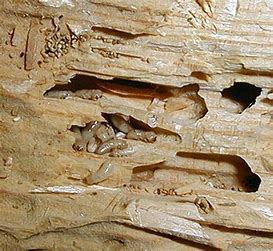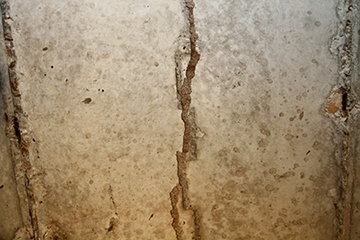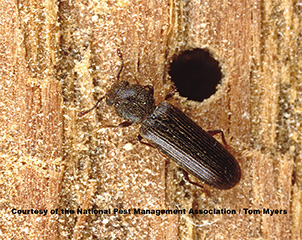-
Wood Destroying Insects
Signs of Termite Infestation


The following list indicates common signs of a subterranean termite infestation:
- The presence of mud-like material that lines the galleries in an irregular pattern.
- Termites may excavate the wood so that only a very thin layer of wood is left on the surface of the cavity and the outside. Then this layer is broken; they will cover the holes with mud like material, used to make the tubes. This is a mixture of soil, feces, and saliva.
- Swarmers: The appearance of a swarm of what you would call "flying ants", especially near light sources This indicates a nest may be near. A "swarm" is a group of adult male and female reproductives that leave their nest to establish a new colony. Swarming occurs when a colony reaches a certain size. Swarming is most common in the spring (March, April, May, and June) and occasionally autumn (September and October).
- Most swarmers emerge during the day, most frequently on warm days after rain. Swarmers found outdoors near tree stumps, railroad ties, etc., are not an indication that your house is infested but are present on the outside only. On the other hand, finding swarmers indoors often means that you have a termite infestation within your house. At first glance, swarmers and ants look similar, but can be distinguished by certain physical features. At Differences between ants and termites, there is a picture and list of differences.
- Mud Tunnels: Subterranean termites maintain their headquarters in the ground and build "mud tubes", pencil-size, that connect the nest (moisture) to the food source (wood).The tunnels may contain broken mud particles with fecal materials. Mud tubes or shelter tubes are proof of termite infestation, but their absence does not necessarily mean that a structure is free of termites. The insects may reach sills and other wood members through cracks or voids in the foundation wall, under the outside stucco, or from earth-filled porches, steps, terraces, or patios. You can break open tubes to determine if termites are still active inside. Termites often rebuild damaged tubes, another indication of continued activity. Old tubes are dry and will crumble easily.
- Subterranean termites construct four types of tubes or tunnels. Working tubes (left) are constructed from nests in the soil to wooden structures; they may travel up concrete or stone foundations. Exploratory and migratory tubes (center) arise from the soil but do not connect to wood structures. Drop tubes (right) extend from wooden structures back to the soil.
- Piles of wings: The shed wings of swarmers indicate termites have entered their next phase of development.
- Live termites: Reproductive kings and queens are 1/2" long, winged and black or brown in color. Workers are sterile and usually hidden within infested wood. They are 1/4" long, wingless and white. However, the absence of finding live termites does not mean that they are not present in the structure.
- Buckling paint or tiny holes on the wood.
- Damaged wood: Wood may appear crushed at structural bearing points. Termite damaged wood resonates with a dull thud (hollow sound)when tapped with a hammer. Pick and probe the surface of an infested piece of wood with a pen knife and you will find tunnels running parallel to the wood's grain.
- Finding termites in a structure does not mean you have an immediate emergency because the rate at which damage occurs is relatively slow.
Powderpost Beetles


True Powderpost Beetles (Lyctidae):
The adults are very small, less than 1/4" in size. They are flattened and reddish-brown to black in color. Larvae are white, cream colored, c shaped with dark brown heads. Larvae create tunnels in the wood and become pupae. As adults, they bore out through the wood, pushing a fine powdery dust out. The shape of their holes are round , about 1/32-1/16 pinholes.
They attack hardwoods depositing their eggs. They can attack bamboo(technically a grass), but because of the large pores they will attack. Their diet is starch, sugar and protein in the sapwood of hardwoods Wood that is less than 6% moisture content is seldom attacked. The life cycle averages one year to complete. This wood-boring beetle is the most widespread in the United States. Many times infestations are built into structures from infested lumber. They can reinfest.
Lycid damage is characterized by:
- Presence of extremely fine, flour-like powder falling from the surface holes.
- The frass left by other wood borers usually contains pellets has a course texture and a tendency to stick together.
- When inspecting damage, be sure to distinguish old damage from active beetle infestations.
- Recently formed holes, and frass(sawdust like) are light in color and clear in appearance; old holes and frass are dark in color.
False Powderpost Beetle (Bostrichidae)
False Powderpost Beetles are larger than other families of powderpost beetles, so their exit holes are larger. These holes do not contain frass, but the galleries do. The frass is tightly packed, tends to stick together and is meal like( contains no pellets)
The adults are 1/8-to 1-inch long, cylindrical, and reddish brown to black. The adults bore into the wood to lay eggs, leaving a hole larger that 1/8 inch, usually in wood less than ten years old.
The larvae are curved and wrinkled. Their diet is dependent on the starch in the wood, they are more common in softwood , but can attack hardwoods. They require 6-30% moisture content in the wood and complete the average life cycle in one year.
Most of the hardwoods attacked are not those commonly found used for interior floors, woodwork or trim. Most of this species does not reinfest wood after it is seasoned, so the damage is limited to that inflicted by one generation. However, the speed of the damage can be considerable. Most of the time they do not reinfest wood after it has been seasoned. They are often found in oak, firewood, and furniture
Carpenter Ants


Appearance:
Carpenter ants are quite large, from 1/4 o 3/8" long; dark brown to black, but some may have a red or yellowish coloration. The usual carpenter ant is large and black, but you can have the Florida Carpenter Ant, which is smaller with a range in colors; yellow, red-brown or black.
Diet:
They eat a variety of plant and animal foods and sweets. These ants will also feed on other insects. They do not digest wood.
Biology:
Being social insects, they have different forms of "castes" in their colonies. Mature colonies have winged and wingless queens, winged males, two sizes of wingless workers, and immature stages(eggs, larvae, and pupae).
- They swarm and mate during the springtime.
- Swarming generally occurs after three-six years, when a colony contains 3,000 or more ants.
- A single queen starts a new colony.
- Damage can occur before a homeowner is aware of the presence of carpenter ants. It takes a while to build up the colony in population before you may take notice of foraging ants or swarmers.
- Carpenter ant colonies inside homes may release swarms indoors.
- Carpenter ants in the house during the winter months or winged carpenter ants indoors at any time of year is a sign that they have a nest somewhere in the house.
- If it is just a few workers, seen during the summer months, more likely they are simply foraging from the outside; entering and exiting.
A carpenter ant colony may contain a main nest and one or more "satellite" nests. The main nest contains the queen, eggs and larvae, and workers. Ants in these "satellite" nests are the ones that normally do structural damage to homes.
During the winter months, the ones outside are inactive. The indoor nest can remain active, but at a reduced rate.
Habits:
They are nocturnal. There activity peaks between 8:00 p.m. and 4 a.m. Their ideal temperature for habitation is between 71 degrees to 74 degrees F. It would be advantageous to inspect at these times and temperature conditions.
- They usually nest outside in moist wood or partially decayed wood in that they prefer the "softened wood" to hollow out their nests called "galleries".
- These galleries are quite clean and have a sandpaper appearance.
- (Termite galleries are rough looking in comparison.)
- Wood, which has been damaged by carpenter ants contains no mud-like material, as is the case with termites.
- Nests are especially common in such places as moist, hollow spaces, like the wall void behind dishwashers.
- Nests are usually found in areas where water leakage could occur, around bathtubs, sinks, roof leaks, poorly flashed chimneys, or poorly sealed windows or door frames.
- Outdoor nest can occur in stumps, hollow logs, fence posts or in dead portions of standing trees. However cracks and crevices may be used to start nests in sound wood.
They may establish nests in some different locations. It is important to understand that you can have both inside and outside nests. They construct two different kinds of nests: parent colonies which, when mature, contain an egg-laying queen, brood and 2000 or more worker ants, and satellite colonies which may have large numbers of worker ants, but no queen, eggs or larvae. The carpenter ants inside a home may have originated from the parent nests located outdoors in a tree stump, timber or woodpile for example. They may also originate from one or more satellite nests hidden behind a wall in the kitchen or bathroom, or perhaps from wood dampened by a roof leak in the attic. Although large colonies can cause structural damage, the damage is not normally as serious as termite damage.
How to detect galleries:
- Many times you can see "sawdust" near these carpenter ant galleries.
- This "sawdust" or "frass", are shredded fragments of wood that has been ejected from the galleries. This is a good indication that a nest is nearby. But sometimes this evidence is not seen, taking a screwdriver, probing the wood may reveal the excavated galleries.
- Also, you could take the blunt end of the screwdriver to tap along baseboards, and other wood surfaces listening for the hollow sound of damaged wood.
- If a nest is nearby, many times the carpenter ants will respond by making a "rustling" sound within the nest, similar to crinkling of cellophane.